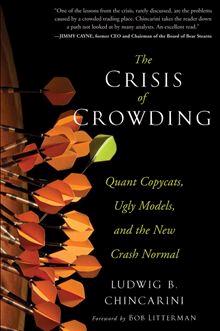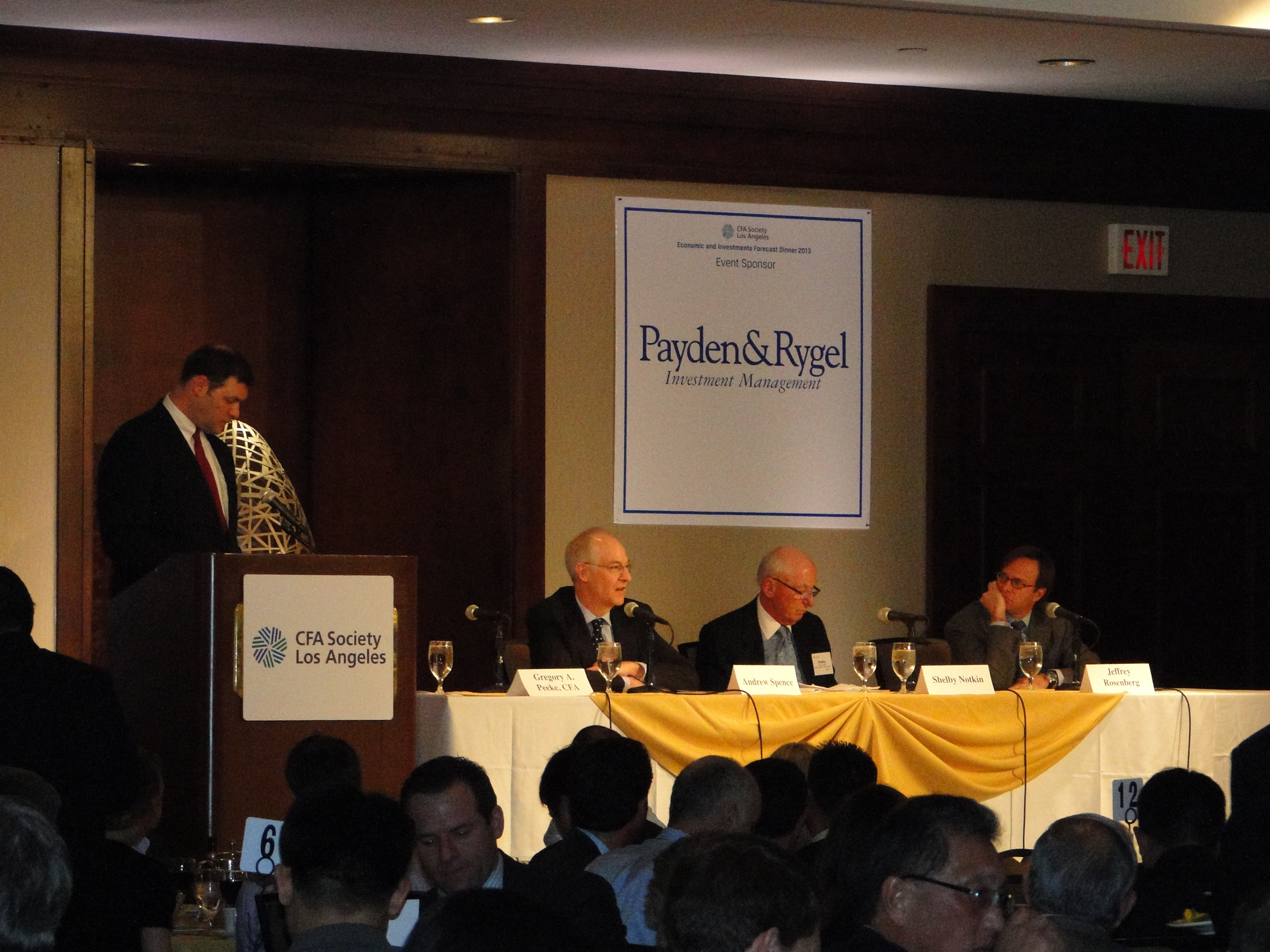Welcome to the CFALA e-newsletter, a periodic publication with stories about noteworthy events and programs sponsored or hosted by the society, guest articles by members, book reviews, and other items of interest to CFALA members. Click on the headlines below to read the full stories. And if you’d like to contribute a story suggestion or, even better, write an article, we’d love to hear from you. Please email Executive Director Laura Carney at laura@cfala.org or steve@silverfoxco.com.
In this issue ...
-
Leverage the CFALA Job Board And Have Your Employer Do So Too!
-
The Crisis of Crowding by Ludwig Chincarini, reviewed by Donald Steinmann President of the Applied Behavioral Finance Group COI, CFALA
-
Claritas Investment Certificate Aims to Broaden Knowledge
-
Global Survey Shows Optimism on Economic Growth, but Acknowledges Distrust of The Financial Services Industry
-
2013 Forecast Dinner Draws Large Crowd; Speakers Upbeat on Stocks, Cautious on Bonds
Leverage the CFALA Job Board And Have Your Employer Do So Too!
By David S. Bradley, CFA, CAIA
Dear CFALA members, please email your head of HR or hiring manager letting them know about the CFALA job board. The job posting section of the Career Center is easy to find from the home page of www.cfala.org. It’s a no brainer for employers. Posting jobs is free, and the applicant pool has far more average investment and financial experience than those on any other forum. Using our board will save them a tremendous amount of time normally spent sifting through resumes of completely unprepared candidates from other sites. I honestly believe our job board is the only place Southern California employers should need to post, but unfortunately that is not what we’re seeing. We currently only reflect a fraction of the available local jobs. As Career Development Committee Chair, it is my goal to change that - but I need your help, so please take the time to email your hiring manager!
Now that you know how you can help us, here’s how we can help you. First, in case you weren’t aware, if you are a CFALA member, searching for jobs is a free benefit of your membership. Using our board will save you time because all jobs are relevant and local. Additionally, you can upload your resume to our Resume Bank. This only contains resumes uploaded in the last six months, so keep yours up to date. The Resume Bank feature can be beneficial for active job seekers, or for those of you currently employed but open to new opportunities. You never know what might drop in your lap! Finally, our Career Development Committee is constantly holding “Happy Hour” chat series events that are also free to members (plus you get a drink ticket). These events are a great way to build your network of other professionals, which our speakers always emphasize as an immensely important component of everyone’s career path.
This process should be an upward spiral. When you email your employer, more awesome jobs will show up on the board, and with more awesome jobs, the board will attract even more awesome candidates. When employers see how well the candidate search goes, they will never post anywhere else again. Soon our board becomes the preeminent job board in Southern California! To make this really easy, you can cut and paste the note from the link below and send it to your employer.
Thanks!
The Crisis of Crowding by Ludwig Chincarini, reviewed by Donald Steinmann President of the Applied Behavioral Finance Group COI, CFALA
 Ludwig Chincarini’s book The Crisis of Crowding examines the forces behind powerful fiscal events over the last 15 years, including the failure of Long Term Capital in 1998, the fiscal crisis of 2008, and the ‘flash crash’ of 2010. Dr. Chincarini proposes an interesting behavioral theory as the root cause to these major financial episodes.
Ludwig Chincarini’s book The Crisis of Crowding examines the forces behind powerful fiscal events over the last 15 years, including the failure of Long Term Capital in 1998, the fiscal crisis of 2008, and the ‘flash crash’ of 2010. Dr. Chincarini proposes an interesting behavioral theory as the root cause to these major financial episodes.
This highly readable book is in three main parts. The first part of the book provides a detailed examination of the failure of Long Term Capital Management in 1998. It includes a blow by blow description of exactly what happened, including interviews with some of the key players at the firm. The second part describes the 2008 financial collapse, starting with the demise of Bear Stearns. In great detail Chincarini describes the collapse of Fannie Mae and Freddy Mac, AIG, and the last straw, the failed rescue of Lehman Brothers. He shares what happened to the hedge funds that were formed from the ashes of LTCM. The third part looks at very recent market calamities including the failure of the Greek economy and the 2010 ‘flash crash’.
According to Chincarini, all of these powerful events have something in common; crowded trades. How would that take place? One company does a number of successful trades. So another firm copies them, then another and another. Soon you have a whole series of nearly identical trades by many players. The players believe they are protected by the diversification of very different positions. But what looks like diversification isn’t actually diversification at all if everyone is doing almost exactly the same trades, especially in illiquid securities. Add significant leverage, and it’s an accident waiting to happen.
The best and most compelling part of the book is the analysis of the downfall of Long Term Capital Management. We are introduced to the major players with biographies and interviews. We find out how the firm came into being, how they had many years of excellent returns. And how that success became their undoing as others copied their methodology for earning above average returns, creating a very crowded market in the same securities.
Particularly intriguing is how different this is from other behavioral phenomena. Humans have been engaged in typical financial behaviors such as anchoring or mental accounting for millennia. However, crowding of the type explored in this book requires computers to make large coordinated trades. So this is a behavior that only goes back possibly 25 years, to the ‘portfolio insurance’ craze that brought about the 1987 stock market crash. The relatively new science of behavioral finance is older than one of the investment fallacies that it describes.
A quote in the book from Han Hufschmid, one of the principals at LTCM, struck me. “In general, one can try and address known problems; it’s the risks that are not known that are dangerous”. It was those unknown risks in crowded markets that have brought us a great deal of financial pain over the last 25 years.
Back to Top
Claritas Investment Certificate Aims to Broaden Knowledge
 While the CFA® charter is one the most widely known and respected investment credentials in the world, only a fraction of those who work in the investment industry hold it. To help remedy the obvious gap that leaves, CFALA is playing a prominent role in a pilot educational program aimed at increasing the knowledge of those who work with investment decision makers.
While the CFA® charter is one the most widely known and respected investment credentials in the world, only a fraction of those who work in the investment industry hold it. To help remedy the obvious gap that leaves, CFALA is playing a prominent role in a pilot educational program aimed at increasing the knowledge of those who work with investment decision makers.
Developed and sponsored by the CFA Institute, the Claritas™ Investment Certificate is designed to give a clear understanding of the essentials of the investment industry and professional responsibilities within it, covering a wide range of topics from regulation, industry structure, and financial instruments to risk and portfolio management. The certificate program is specifically designed for individuals outside of investment roles or with limited formal training in investments, including those who work in operations, sales and marketing, as well as those new to the investment industry. Designed as an easy-to-use, self-study program, the course involves up to 100 hours of study, with those candidates who pass the two-hour multiple choice proctored exam receiving a Certificate of Knowledge from the CFA Institute. Those who are successful will emerge from the program with an understanding of investment fundamentals and how the industry works.
“Not everyone has the time or the wherewithal to pursue the CFA charter – Claritas will go a long way toward providing individuals a solid introductory background on the industry,” explains Nathan Palmer, CFA, Vice President and Portfolio Manager at Wilshire Associates, who serves as coordinator for the CFALA effort and liaison with CFA Institute for the Claritas Investment Certificate.
While CFA Institute is working with educational firms to roll out Claritas globally, CFALA is offering its own instruction series designed specifically around the Claritas program, with classes beginning at the end of January. “To my knowledge, we are the first CFA Society to introduce our own instructional series,” Palmer said. “We’d like to host two instructional series a year, one at the CFALA offices downtown and potentially another one in West Los Angeles. In between, we would love to take the instructional series on the road, bringing the program to some of L.A.’s larger investment firms, making it easier for their employees to pursue this.”
Once the pilot program is concluded in April, the CFA Institute plans to launch the Claritas program globally in May of 2013. If Palmer’s experience at Wilshire is any indication, it will be a hit.
“I’m proud Wilshire will be the first investment firm to host CFALA’s instruction series,” which will span seven weeks and be instructed by local university professors and investment practitioners. “I hope what we’re doing here at Wilshire can serve as a model for other large investment firms going forward,” he said. “I sent an email about the program to roughly 200 people in our Santa Monica offices, about half of whom are in the target audience, and within three hours more than 25 people signed up. People here are very enthusiastic about Claritas. In my opinion, there simply weren’t any options out there that satisfy this need in the marketplace…until now.”
More information about Claritas can be found at www.cfainstitute.org/programs/claritas
Global Survey Shows Optimism on Economic Growth, but Acknowledges Distrust of The Financial Services Industry
Investment professionals responding to this year’s CFA Institute Global Market Sentiment Survey generally expect the global economy to expand or stay the same in 2013, with a higher proportion of members this year (40%) anticipating expansion than last year (34%). Respondents also were slightly more positive about employment opportunities for financial professionals than they were a year ago.
While CFA Institute members in developing economies were more optimistic about local economic growth (35%), a higher percentage (42%) of members in advanced economies expected global economic expansion in 2013. The biggest concerns those in for local markets include weak economic conditions in advanced economies (38%), political instability in developing economies (18%), and the European sovereign debt crisis in Europe (17%).
The United States, China, and Brazil will provide the best investment opportunity among worldwide equity markets this year, the respondents said.
CFA Institute members were essentially unanimous (99%) in acknowledging distrust in the financial industry, with most respondents (56%) saying that a lack of ethical culture within financial firms has contributed to the problem. Members felt ethical culture within financial firms needs to be changed to solve systemic problems that led to the fiscal crisis, with that change coming from the top. Leading financial institutions all have codes of conduct to foster ethical conduct, the respondents noted, while adding that it takes active leadership to make this promise a reality and ensure that investment managers put client interests first.
The CFA Institute Global Market Sentiment Survey was created to seek input from CFA Institute members and gather feedback on market sentiment, performance, and market integrity issues, and to further the institute’s mission of promoting ethical and trustworthy investment markets. The 2013 survey was conducted online between Oct. 30, and Nov. 13, 2012. All CFA Institute members globally (115,096) were invited to participate in the survey and 6,783 responded, for an overall response rate of 6% and a margin of error of ±1.2%. In addition to analysis and reporting at the global, regional, and advanced versus developing economies level, 22 countries were also included in the final report.
For a complete copy of the survey, go to http://www.cfainstitute.org/about/research/surveys/Pages/global_market_sentiment_survey_2013.aspx
2013 Forecast Dinner Draws Large Crowd; Speakers Upbeat on Stocks, Cautious on Bonds

Providing the macro outlook was Andrew Spence, Multi-Strategy Portfolio Managing Director at OMERS, one of Canada’s largest pension plans. Spence said investor preoccupation with the fiscal cliff had overshadowed the reality of a pickup in the pace of economic recovery that includes a true bottom for housing, falling unemployment and rising consumption.
Spence said investors should ask: “Where’s the value proposition, and what’s my downside risk?” The answer, he said, is: “The value is in equities, and the risk is in central banks. With that in mind, what is the most likely macro outcome, and what is priced in?
“The only near-term drag now is fiscal consolidation, which is doubling to 2.0% of GDP in the first half but eases off in the second half,” he said. “But what’s priced in? Deleveraging and the half-speed recovery. The market is not priced for a U.S. economy that is capable of reaching escape velocity, and this is a great opportunity.”
Fixed income investors need to embrace a new set of parameters and expectations for 2013 and beyond, said Jeffrey Rosenberg, CFA, Managing Director and Chief Investment Strategist for Fixed Income at BlackRock, Inc.
“Fixed income returns benefited from everything going right in 2012,” Rosenberg said. “However, achieving similar results in 2013 will be much harder. Investors should adjust their fixed income return expectations lower for 2013 – much lower. For 2013, we expect ‘core’ fixed income benchmark returns only in the region of 1-2%, with returns only in the 2-3% region for the average bond fund.”
Commenting on widespread descriptions of bonds as being in a “bubble,” Rosenberg disagreed.
“An asset price bubble is when the expectation that the price can only go higher forms the only rationale for purchase,” he said. “But the main motivation of investors for buying fixed income is the opposite of typical bubbles – the fear of losing money rather than the greed of potential profit has fueled the historic shift of assets into fixed income. The risk for investors in 2013 is that even with our outlook for only modest increases in interest rates, returns in core fixed income will not keep up with inflation. However, rates at the higher end of our scenario may lead to negative returns, even before considering the impact of inflation.”
On the equities front, Shelby Notkin, Chairman of Capital Group Private Client Services, noted that stocks around the world did well in 2012 despite various uncertainties and said his firm is generally upbeat about the year ahead.
The annual forecast dinner benefits the California Council on Economic Education, which this year honored Sasha Guzman, who teaches at the Student Empowerment Academy in South Central Los Angeles, as CCEE’s teacher of the year. Moderator for the evening was Gregory A. Peeke, CFA, CIO and portfolio manager of Skrimshaw Investment Management, LLC. Event sponsors included Payden & Rygel and Barclays Capital.

